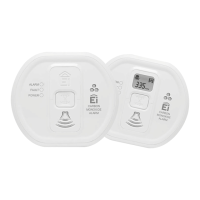27
UNIT BY” date has been reached. Check the label on the side of the Alarm.
(5) CO Alarms are not a substitute for life insurance. House-holders are responsible for their
own insurance. The CO Alarm warns of increasing CO levels, but we do not guarantee
that this will protect everyone from CO poisoning.
(6) CO Alarms are not suitable as early warning Smoke Alarms. Some fires produce Carbon
Monoxide, but the response characteristics of these CO Alarms are such that they would
not give sufficient warning of fire. Smoke Alarms must be fitted to give early warning
of fire.
(7) The CO Alarm does not detect the presence of natural gas (methane), bottled gas
(propane, butane) or other combustible gases. Fit combustion Gas Alarms to detect
these. Note: Carbon Monoxide Alarms, with electrochemical sensors have a cross
sensitivity to hydrogen. This means that they can alarm due to sensing hydrogen
being produced by batteries being incorrectly charged such as on boats or with battery
back-up systems such as those used with alternative energy systems. The CO Alarm will
alarm with 500 ppm H2 after between 10 and 40 minutes exposure.
WARNING: THIS CO ALARM IS DESIGNED TO PROTECT INDIVIDUALS FROM THE ACUTE
EFFECTS OF CARBON MONOXIDE EXPOSURE. IT WILL NOT FULLY SAFEGUARD INDIVIDUALS
WITH SPECIFIC MEDICAL CONDITIONS. IF IN DOUBT CONSULT A MEDICAL PRACTITIONER.

